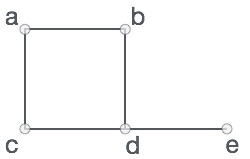Python-グラフ
グラフは、オブジェクトのペアがリンクで接続されているオブジェクトのセットを図で表したものです。相互接続されたオブジェクトは頂点と呼ばれるポイントで表され、頂点を接続するリンクはエッジと呼ばれます。グラフに関連するさまざまな用語と機能については、こちらのチュートリアルで詳しく説明しています。この章では、Pythonプログラムを使用してグラフを作成し、グラフにさまざまなデータ要素を追加する方法を説明します。以下は、グラフに対して実行する基本的な操作です。
- グラフの頂点を表示する
- グラフのエッジを表示する
- 頂点を追加する
- エッジを追加する
- グラフの作成
グラフは、Python辞書のデータ型を使用して簡単に表示できます。頂点を辞書のキーとして表し、頂点間の接続をエッジとも呼ばれ、辞書の値として表します。
次のグラフを見てください-

上のグラフでは
V = {a, b, c, d, e}
E = {ab, ac, bd, cd, de}このグラフは、次のようにPythonプログラムで表示できます。
# Create the dictionary with graph elements
graph = { "a" : ["b","c"],
"b" : ["a", "d"],
"c" : ["a", "d"],
"d" : ["e"],
"e" : ["d"]
}
# Print the graph
print(graph)上記のコードを実行すると、次の結果が得られます。
{'c': ['a', 'd'], 'a': ['b', 'c'], 'e': ['d'], 'd': ['e'], 'b': ['a', 'd']}グラフの頂点を表示する
グラフの頂点を表示するには、グラフ辞書のキーを簡単に見つけます。keys()メソッドを使用します。
class graph:
def __init__(self,gdict=None):
if gdict is None:
gdict = []
self.gdict = gdict
# Get the keys of the dictionary
def getVertices(self):
return list(self.gdict.keys())
# Create the dictionary with graph elements
graph_elements = { "a" : ["b","c"],
"b" : ["a", "d"],
"c" : ["a", "d"],
"d" : ["e"],
"e" : ["d"]
}
g = graph(graph_elements)
print(g.getVertices())上記のコードを実行すると、次の結果が得られます。
['d', 'b', 'e', 'c', 'a']グラフのエッジを表示する
グラフのエッジを見つけることは、頂点の間にエッジがある頂点のペアのそれぞれを見つける必要があるため、頂点よりも少しトリッキーです。したがって、エッジの空のリストを作成してから、各頂点に関連付けられたエッジ値を反復処理します。頂点から見つかったエッジの個別のグループを含むリストが形成されます。
class graph:
def __init__(self,gdict=None):
if gdict is None:
gdict = {}
self.gdict = gdict
def edges(self):
return self.findedges()
# Find the distinct list of edges
def findedges(self):
edgename = []
for vrtx in self.gdict:
for nxtvrtx in self.gdict[vrtx]:
if {nxtvrtx, vrtx} not in edgename:
edgename.append({vrtx, nxtvrtx})
return edgename
# Create the dictionary with graph elements
graph_elements = { "a" : ["b","c"],
"b" : ["a", "d"],
"c" : ["a", "d"],
"d" : ["e"],
"e" : ["d"]
}
g = graph(graph_elements)
print(g.edges())上記のコードを実行すると、次の結果が得られます。
[{'b', 'a'}, {'b', 'd'}, {'e', 'd'}, {'a', 'c'}, {'c', 'd'}]頂点の追加
頂点の追加は簡単で、グラフディクショナリに別のキーを追加します。
class graph:
def __init__(self,gdict=None):
if gdict is None:
gdict = {}
self.gdict = gdict
def getVertices(self):
return list(self.gdict.keys())
# Add the vertex as a key
def addVertex(self, vrtx):
if vrtx not in self.gdict:
self.gdict[vrtx] = []
# Create the dictionary with graph elements
graph_elements = { "a" : ["b","c"],
"b" : ["a", "d"],
"c" : ["a", "d"],
"d" : ["e"],
"e" : ["d"]
}
g = graph(graph_elements)
g.addVertex("f")
print(g.getVertices())上記のコードを実行すると、次の結果が得られます。
['f', 'e', 'b', 'a', 'c','d']エッジを追加する
既存のグラフにエッジを追加するには、新しい頂点をタプルとして扱い、エッジがすでに存在するかどうかを検証する必要があります。そうでない場合は、エッジが追加されます。
class graph:
def __init__(self,gdict=None):
if gdict is None:
gdict = {}
self.gdict = gdict
def edges(self):
return self.findedges()
# Add the new edge
def AddEdge(self, edge):
edge = set(edge)
(vrtx1, vrtx2) = tuple(edge)
if vrtx1 in self.gdict:
self.gdict[vrtx1].append(vrtx2)
else:
self.gdict[vrtx1] = [vrtx2]
# List the edge names
def findedges(self):
edgename = []
for vrtx in self.gdict:
for nxtvrtx in self.gdict[vrtx]:
if {nxtvrtx, vrtx} not in edgename:
edgename.append({vrtx, nxtvrtx})
return edgename
# Create the dictionary with graph elements
graph_elements = { "a" : ["b","c"],
"b" : ["a", "d"],
"c" : ["a", "d"],
"d" : ["e"],
"e" : ["d"]
}
g = graph(graph_elements)
g.AddEdge({'a','e'})
g.AddEdge({'a','c'})
print(g.edges())上記のコードを実行すると、次の結果が得られます。
[{'e', 'd'}, {'b', 'a'}, {'b', 'd'}, {'a', 'c'}, {'a', 'e'}, {'c', 'd'}]